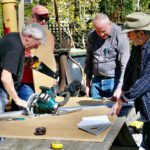Home »

Koryta masters the psychological thriller
Book Review
By Derryll White
Koryta, Michael (2015). Last Words.
Michael Koryta worked as a newspaper reporter and private investigator, and is the author of 10 novels. I haven’t read him before but he brings good credentials to this new work. His primary character, private snoop Mark Novak, is a recurring figure, here mourning the death of his lawyer wife during a case they were working together. Her last words to him were, “Mark, your personal understanding of the world doesn’t invalidate another’s.” And his to her were: “Don’t embarrass me with this shit.” Not a great way to part for eternity.
 Novak is looking for solutions to the death 10 years earlier of a young girl in a cave. He has a lot of anger and darkness from his own background, and this Koryta marries with the forbidding gloom of the deep cave. The image of a cave works well with death, interment, loss and the dark anger experienced in the small Indiana town of Garrison where Sarah Martin, the dead girl, had lived.
Novak is looking for solutions to the death 10 years earlier of a young girl in a cave. He has a lot of anger and darkness from his own background, and this Koryta marries with the forbidding gloom of the deep cave. The image of a cave works well with death, interment, loss and the dark anger experienced in the small Indiana town of Garrison where Sarah Martin, the dead girl, had lived.
One of the things Koryta does well in ‘Last Words’ is to have the reader examine the impact of the past on the present. Mark Novak flashes back to earlier portions of his life, letting them inform his present actions. We all do that, but seldom recognize it. Mark uses his past as a lever to pry open the present.
‘Last Words’ is a complex story with a lot to think about. Koryta examines caving, hypnotism, the relations between people and dogs, and the deep psychology of inter-personal relationships. He demands that his readers think as he sweeps them along with the ever-evolving story.
The images are sometimes claustrophobic but the demands that Mark Novak places upon himself are inspiring. Koryta has mastered the psychological thriller and is as dark as the new Scandinavian writers. I will read more of him.
****
Excerpts from the novel:
THE CAVES – Southern Indiana was a karst landscape, which meant that it existed above a world honeycombed with caves, caverns and crevices. The bedrock was made of limestone and dolomite, types of rock that allowed water to eat it away and carve a new world. The land was home to springs where water bubbled up from below, sinkholes where the surface was pulled underground, a river that vanished for miles at a time – countless collisions between worlds above and worlds below.
RESOURCES – Stop thinking about all the ways it’s bad. Just concentrate on going forward. On doing the one thing you can do to help yourself. There’s nothing left of you now but the essential. The only resources you have are in your mind and body. Don’t waste them.
CAVING – Don’t do that, he scolded himself. The minute you began to worry about getting back out, panic could rise, claustrophobia could set in. One of the great myths of caving was that regulars couldn’t be touched by claustrophobia. That was what the weekend warriors said, maybe, but people who’d spent enough time underground had either seen others get stuck, or gotten stuck themselves, or both. Real cavers understood real consequences.
 – Derryll White once wrote books but now chooses to read and write about them. When not reading he writes history for the web at www.basininstitute.org.
– Derryll White once wrote books but now chooses to read and write about them. When not reading he writes history for the web at www.basininstitute.org.







